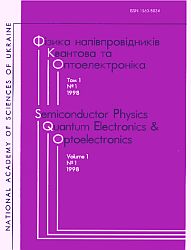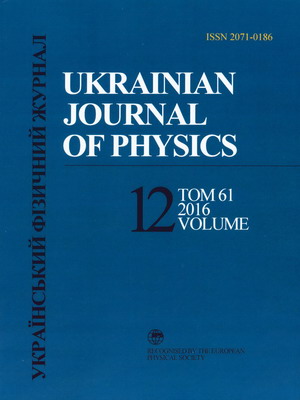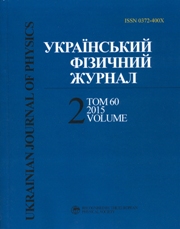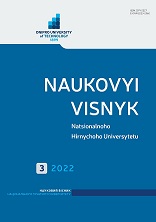
Бази даних
Наукова періодика України - результати пошуку
 |
Для швидкої роботи та реалізації всіх функціональних можливостей пошукової системи використовуйте браузер "Mozilla Firefox" |
|
|
Повнотекстовий пошук
| Знайдено в інших БД: | Книжкові видання та компакт-диски (1) | Реферативна база даних (17) |
Список видань за алфавітом назв: Авторський покажчик Покажчик назв публікацій  |
Пошуковий запит: (<.>A=Rudko G$<.>) | |||
|
Загальна кількість знайдених документів : 12 Представлено документи з 1 до 12 |
|||
| 1. | 
Fediv V. I. Synthesis route and optical characterization of CdS:Mn / polyvinyl alcohol nanocomposite [Електронний ресурс] / V. I. Fediv, G. Yu. Rudko, A. I. Savchuk, E. G. Gule, A. G. Voloshchuk // Semiconductor physics, quantum electronics & optoelectronics. - 2012. - Vol. 15, № 2. - С. 117-123. - Режим доступу: http://nbuv.gov.ua/UJRN/MSMW_2012_15_2_4 CdS nanoparticles doped with Mn have been synthesized in aqueous solution by using polyvinyl alcohol as a capping reagent. Influence of the polymer concentration on the size and concentration of the nanoparticles was studied using transmission electron microscopy and optical absorption. Incorporation of Mn<^>2+ | ||
| 2. | 
Fediv V. I. Synthesis of Mn2+-doped CdS nanoparticles covered with different adsorptive layers and their application as biosensors [Електронний ресурс] / V. I. Fediv, G. Yu. Rudko, A. I. Savchuk, E. G. Gule, І. S. Davydenko, O. I. Olar, K. S. Volkov // Semiconductor physics, quantum electronics & optoelectronics. - 2014. - Vol. 17, № 1. - С. 46-51. - Режим доступу: http://nbuv.gov.ua/UJRN/MSMW_2014_17_1_11 | ||
| 3. | 
Rudko G. Yu. Nucleation and growth kinetics of colloidal nanoparticles CdS:Mn in aqueous solution of polyvinyl alcohol [Електронний ресурс] / G. Yu. Rudko, V. I. Fediv, А. I. Savchuk, E. G. Gule, I. P. Vorona, V. V. Nosenko // Semiconductor physics, quantum electronics & optoelectronics. - 2014. - Vol. 17, № 3. - С. 222-226. - Режим доступу: http://nbuv.gov.ua/UJRN/MSMW_2014_17_3_4 Colloidal undoped CdS and doped CdS:Mn nanoparticles were synthesized in the solution of polyvinyl alcohol polymer, and the process of nanoparticles growth was monitored by optical absorption measurements. The inclusion of Mn<^>2+ | ||
| 4. | 
Rudko G. Yu. Zinc oxide nanoparticles fabricated in the porous silica matrix by the sublimation method [Електронний ресурс] / G. Yu. Rudko, S. A. Kovalenko, E. G. Gule, V. V. Bobyk, V. M. Solomakha, A. B. Bogoslovskaya // Semiconductor physics, quantum electronics & optoelectronics. - 2015. - Vol. 18, № 1. - С. 20-25. - Режим доступу: http://nbuv.gov.ua/UJRN/MSMW_2015_18_1_5 The nanocomposite - nanoporous silica (SBA-16) containing ZnO quantum dots - was fabricated by the sublimation method. This novel route of synthesizing ZnO nanoparticles implies physical sorption of zinc acetylacetonate precursor into the matrix pores from the gaseous phase, hydrolysis of the precursor, and thermal decomposition of the product with formation of ZnO nanoclusters directly inside the pores. The nanocomposite was characterized by XRD, nitrogen adsorption-desorption isotherms, and photoluminescence spectroscopy methods. We observed the blue shift of the ultraviolet luminescence of nanocomposite as compared to the luminescence of ZnO nanopowder as well as the decrease of the linewidth of the ultraviolet luminescence line, which points to the encapsulation of ZnO nanoparticles in the silica pores and narrowing of their size distribution. | ||
| 5. | 
Kovalchuk A. O. Analysis of conditions for synthesis of CdS:Mn nanoparticles [Електронний ресурс] / A. O. Kovalchuk, G. Yu. Rudko, V. I. Fediv, E. G. Gule // Semiconductor physics, quantum electronics & optoelectronics. - 2015. - Vol. 18, № 1. - С. 74-78. - Режим доступу: http://nbuv.gov.ua/UJRN/MSMW_2015_18_1_15 The detailed analysis of the synthesis of CdS:Mn nanoparticles in polyvinyl alcohol polymeric matrix is presented and the ranges of optimal growth parameters are determined. The estimated values of parameters were used to produce solutions of CdS:Mn nanoparticles and corresponding solid composites. The sizes of nanoparticles and structure of composite films were characterized by electron microscopy methods, optical properties were probed using photoluminescence methods. | ||
| 6. | 
Rudko G. Yu. Structural and photoluminescence properties of ZnO nanowires [Електронний ресурс] / G. Yu. Rudko, I. V. Dubrovin, A. I. Klimovskaya, E. G. Gule, P. M. Lytvyn, Yu. M. Lytvyn, S. P. Turanska // Ukrainian journal of physics. - 2012. - Vol. 57, № 12. - С. 1239-1243. - Режим доступу: http://nbuv.gov.ua/UJRN/Ukjourph_2012_57_12_9 Масиви нанодротів ZnO вирощено за механізмом пара - рідина - кристал на кремнієвих підкладках і досліджено за допомогою методів рентгенівської дифрактометрії, сканувальної електронної мікроскопії та атомно-силової мікроскопії. Результати цих досліджень свідчать про те, що діаметри нанодротів варіюються в межах 50 - 300 нм, а їх довжина сягає 40 мкм. Для вирощених нанодротів є характерною інтенсивна фотолюмінесценція, в спектрі якої домінують близькокрайова смуга та одна чи дві (залежно від умов вирощування) дефектні смуги. Співвідношення інтенсивностей цих смуг відображає нестехіометричність матеріалу і залежить від температури випаровування цинку та температури в зоні росту нанодротів. | ||
| 7. | 
Rudko G. Yu. Comparison of the synthesis routes for the ZnO/porous silica nanocomposite [Електронний ресурс] / G. Yu. Rudko, S. A. Kovalenko, E. G. Gule, V. V. Bobyk, V. M. Solomakha, A. B. Bogoslovskaya // Semiconductor physics, quantum electronics & optoelectronics. - 2016. - Vol. 19, № 4. - С. 352-357. - Режим доступу: http://nbuv.gov.ua/UJRN/MSMW_2016_19_4_7 ZnO/porous silica nanocomposites were successfully fabricated by three different types of synthesis techniques. In all cases, the molecular sieve SBA-16 was used as a porous matrix. The in situ growth the nanoparticles of zinc oxide within the matrix pores was done using either gaseous or liquid precursors. The ex-situ method implied growing of nanoparticles in a colloidal solution with further penetration of the ripened ZnO nanoparticles into the pores of the matrix. Physico-chemical studies of the synthesized ZnO/porous silica nanocomposites showed that the introduction of zinc oxide by any of the methods did not lead to destruction of the structure of the molecular matrix SBA-16. The structure of ZnO nanoparticles, on the contrary, was strongly dependent on the growing method. The best defectless ZnO nanoparticles were obtained by in situ growing using gaseous precursors. | ||
| 8. | 
Rudko G. Yu. Structural and photoluminescence properties of ZnO nanowires [Електронний ресурс] / G. Yu. Rudko, I. V. Dubrovin, A. I. Klimovskaya, E. G. Gule, P. M. Lytvyn, Yu. M. Lytvyn, S. P. Turanska // Український фізичний журнал. - 2012. - Т. 57, № 12. - С. 1240-1244. - Режим доступу: http://nbuv.gov.ua/UJRN/UPhJ_2012_57_12_9 Масиви нанодротів ZnO вирощено за механізмом пара - рідина - кристал на кремнієвих підкладках і досліджено за допомогою методів рентгенівської дифрактометрії, сканувальної електронної мікроскопії та атомно-силової мікроскопії. Результати цих досліджень свідчать про те, що діаметри нанодротів варіюються в межах 50 - 300 нм, а їх довжина сягає 40 мкм. Для вирощених нанодротів є характерною інтенсивна фотолюмінесценція, в спектрі якої домінують близькокрайова смуга та одна чи дві (залежно від умов вирощування) дефектні смуги. Співвідношення інтенсивностей цих смуг відображає нестехіометричність матеріалу і залежить від температури випаровування цинку та температури в зоні росту нанодротів. | ||
| 9. | 
Rudko G. Yu. Novel concepts of negative-n optics in master’s level educational courses [Електронний ресурс] / G. Yu. Rudko // Semiconductor physics, quantum electronics & optoelectronics. - 2017. - Vol. 20, № 2. - С. 235-239. - Режим доступу: http://nbuv.gov.ua/UJRN/MSMW_2017_20_2_17 The novel ideas of negative refraction index (n) optics suitable for teaching special courses in universities at master's level are systematized and analyzed. The most important innovative ideas in this field are recounted in the logical order necessary for achieving the best understanding of the material. They are: the opposite signs of phase and group velocities of light; the change of the ordered right-hand triad of vectors E, B and V from the right-handed to the left-handed one; the change of the sign of the Doppler effect; the bent of the incident light, when entering the negative n material, in the "wrong" direction; the emergence of new class of materials - artificial metamaterials that have negative n; current state of the search for possibilities to achieve invisibility. | ||
| 10. | 
Rudko G. Yu. Optically detected magnetic resonance study of relaxation/emission processes in the nanoparticle-polymer composite [Електронний ресурс] / G. Yu. Rudko, I. P. Vorona, V. M. Dzhagan, A. E. Raevskaya, O. L. Stroyuk, V. I. Fediv, A. O. Kovalchuk, Jan E. Stehr, M. Chen WeiMin, I. A. Buyanova // Semiconductor physics, quantum electronics & optoelectronics. - 2019. - Vol. 22, № 3. - С. 310-318. - Режим доступу: http://nbuv.gov.ua/UJRN/MSMW_2019_22_3_9 Two nanocomposites containing CdS nanoparticles in polymeric matrices were studied using the photoluminescence (PL) and optically detected magnetic resonance (ODMR) methods. Due to equal sizes of NPs in the composites (~ 5 nm) but different matrices - the oxygen-containing polymer PVA (polyvinyl alcohol) and oxygen-free polymer PEI (polyethyleneimine) - differences of nanocomposites properties are predominantly caused by different interfacial conditions. ODMR spectra have revealed five types of centers related to the PL emission - four centers involved in radiative recombination and one center related to non-radiative recombination processes. The oxygen-related interfacial center in CdS/PVA (LK1-center) and sulfur vacancy center in CdS/PEI (Vs-center) were identified. | ||
| 11. | 
Issatayeva F.М. Technical and economic substantiation of developing Kusmuryn copper deposit (Kazakhstan) [Електронний ресурс] / F.М. Issatayeva, G. I. Rudko, V.S. Portnov // Науковий вісник Національного гірничого університету. - 2019. - № 6. - С. 19-24. - Режим доступу: http://nbuv.gov.ua/UJRN/Nvngu_2019_6_5 Purpose. Substantiation of an economically feasible method for developing the Kusmuryn deposit. Methodology. Analysis of literature and stock materials; studying physical and mechanical properties of rocks and ores. Findings. To improve economic performance and to reduce the cost of concentrate at the Kusmuryn deposit, the mining system is being changed. To replace the chamber-and-pillar development system, which allows extracting all the available reserves, a more effective model was introduced: development of inter-chamber pillars with a high metal content. The authors proved the expediency of development by the open method using the development system with horizontal layers with the goaf stowing. Originality. Calculating the technical and economic indicators of the three mining options allowed selecting the most effective mining method at the Kusmuryn deposit. In order to prevent underground fires, a layer caving system with siltation of crushed rocks is recommended. For disseminated ores, the usual method with collapsing overlying rocks is applicable. Practical value. Based on the studies, recommendations were developed for the Kazakhmys Corporation. They are referred to reducing the open pit mining at the Kusmuryn field in 2019. This stabilizes the achieved production level and compensates for retiring functioning facilities associated with the field. The introduction of underground mining is recommended from 2021. | ||
| 12. | 
Rudko G. Yu. Light-emitting properties of BN synthesized by different techniques [Електронний ресурс] / G. Yu. Rudko, L. L. Sartinska, O. F. Isaieva, E. G. Gule, T. Eren, E. Altay // Semiconductor physics, quantum electronics & optoelectronics. - 2020. - Vol. 23, № 2. - С. 193-200. - Режим доступу: http://nbuv.gov.ua/UJRN/MSMW_2020_23_2_15 Light-emitting properties of boron nitride powders of different morphology grown using various techniques have been studied. All samples were hexagonal BN (h-BN), while the content of impurity phases varied considerably. The wide photoluminescence band in the visible range has been observed. h-BN synthesized using carbothermal reduction method exhibited the highest efficiency of the photoluminescence emission. The intensity of BN emission has been interpreted in terms of interplay between the emission of intrinsic defects stabilized by carbon, carbon-related recombination centers and the centers of non-radiative recombination caused by the presence of sassolite phases in the samples. | ||
 |
| Відділ наукової організації електронних інформаційних ресурсів |
 Пам`ятка користувача Пам`ятка користувача |